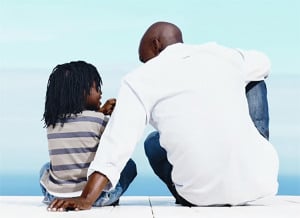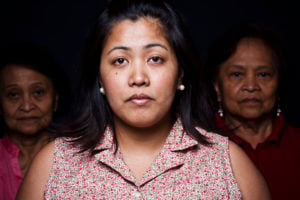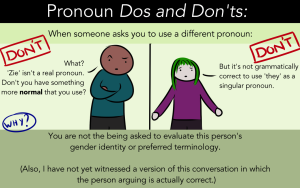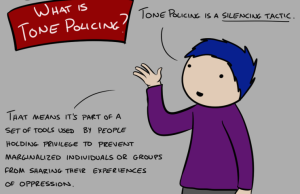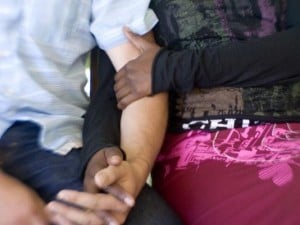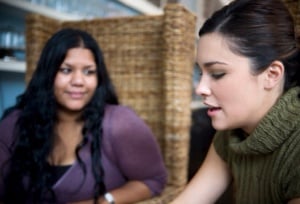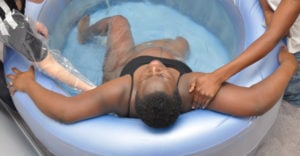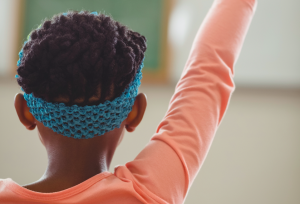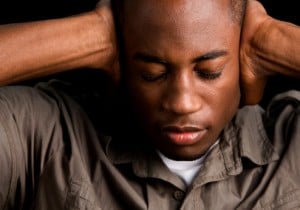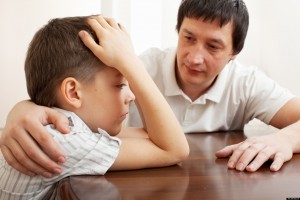
Source: UCSF
The silence of eight-year-old Relisha Rudd is louder than a siren.
Her picture is everywhere in some cities, and her story has been told time and time again: On February 26, 2014, she left the relative safety of the homeless shelter where she and her family stayed. She was lured by a predator who gained her trust with false kindness and food. She was taken to a local motel after which, subsequent crime scenes show, her abductor murdered his wife and killed himself.
Relisha Rudd is still missing.
Along with Relisha, 800,000 total children are missing in America, and there has been a recent, severe spike in the reporting of child pornography, child enticement, and child trafficking cases, according to the National Center for Missing and Exploited Children.
Furthermore, the U.S. Department of Justice reports that more than half of all rapes of women (54%) occur before age 18; 22% of these rapes occur before the age of 12.
The silence of young Relisha Rudd, of the 276 Nigerian school girls half a world away from her, and of the thousands upon thousands of child sufferers of abuse, assault, and abduction between them unwillingly call us to a greater understanding of how to protect our young.
Thankfully, experts in violence against children — and survivors of childhood violence — are speaking.
Their advice about child protection from predators can be roughly broken down into seven areas of advice for caregivers. This two-part series explores what parents, grandparents, extended family, teachers, neighbors, and other caregivers can do to empower the children we love and reduce the likelihood of victimization among them.
Part I covers the basic best practices for child protection. Part II explores more nuanced areas for us to model, cultivate, and support in our youth as they grow to better protect themselves.
This article makes use of several classics and some lesser well-known, but equally outstanding works in the field of children’s self-defense and protection. I hope you will seek them in your studies.
1. Study and Learn
Often times, people rely on popular wisdom, fear tactics of the media, myths, or stereotypes to inform them in their efforts to keep the children they love safe.
Be wary of simplistic myths that don’t reflect the realities of safety and self-defense, especially of the “Don’t talk to strangers” and “Find a police officer, store manager, or security guard if you’re in trouble or lost” tropes.
These oft-repeated safety guidelines are neither entirely true, nor entirely untrue and can undermine kids’ critical thinking in times of danger, according to violence prevention expert and author Gavin DeBecker.
He asserts that many strangers are not dangerous, and that your child may do well to seek help from a stranger in a crisis. Furthermore, children see adult caregivers interact with strangers all the time, thus creating a mixed message.
Instead, we should study the works of the experts — who themselves have studied violence, violence prevention, predator behavior, and effective child-defense against predators — and learn what they have to say about violence prevention for children.
As you study and learn, adjust what you know for your culture, experience, and reality. Self-defense experts have large audiences and often speak in broad terms, even when they cite individual cases. Some children’s self-defense experts may have class and cultural biases or experiential bases that differ from yours. If your life differs in culture, prevalence of various types of predators, or some other important distinction, adjust your understanding accordingly.
2. Teach the Basics
“Teach children their full name, address, and home phone number,” says Gavin DeBecker in his book Protecting the Gift. He also says to teach them your full name and make sure they know how to reach you at work and on your cellphone.
Furthermore, he suggests: “Teach children how and when to use 911, and make sure they have a trusted adult to call if they’re scared or have an emergency. Teach children if anyone tries to grab them, they should make a scene and make every effort to get away by kicking, screaming, and resisting.”
Teach children “it’s okay to withdraw consent at any time, their body is theirs, how to talk about the body, how to say No, [and] to keep telling if nobody listens and if nobody makes it stop.”
Furthermore, consider teaching children to “seek help from a woman” if in danger. While this naturally goes against our goal of dismantling gender stereotypes, according to DeBecker, women are more likely to see a crisis with a child through to its end – and are, statistically speaking, far less likely to be child predators.
Train children in selecting safe-seeming adults and in communicating assertively with them before an emergency and while they are in your care.
One mother cited in DeBecker’s work goes out with her daughter and sends the child on small stranger errands, like asking for directions or minor assistance. The mother watches from a safe distance and then discusses with her daughter her choice of stranger and the subsequent interactions.
Introduce the language of safety and self-protection in ways that work for you and the children in your care. Kids should know key terms and meanings for trusted adult, unknown person (stranger), dangerous person, aggressive predator, luring predator, bully, boundary, consent, non-consent, private parts, privacy, and so on.
According to child protection advocate Kenneth Wooden, children are especially vulnerable to being lured by predators. Familiarize them with luring tactics, perhaps making the link in kid-friendly ways, like exploring the nature and purpose of lures in the natural world (e.g., Venus fly traps and angler fish) or in sport (e.g., fishing).
Be specific about what constitutes good touch and bad touch. Irene Van Der Zande, author of The KIDPOWER Book for Caring Adults suggests that “good touch” may be defined as touch for health, hygiene, or appropriate affection. “Bad touch” is aggressive, hurtful, painful, inappropriate, or uncomfortable.
Let girls and boys know that they have options other than going along with the agenda of someone who’s trying to harm them. They can, according to Washington, DC’s Defend Yourself run, yell, tell, hit, or “go along if they’re trying to take your stuff (not to hurt you) or if you think it is the safest way to survive the attack.”
Remember to remind kids regularly, as DeBecker suggests, that “if someone says ‘Don’t yell,’ the thing to do is yell [and] if someone says ‘Don’t tell,’ the thing to do is tell.”
3. Set Rules
Set these three basic rules for safety for the children in your care (from The National Center for Missing & Exploited Children):
- Check first with parents, guardians, or other trusted adults before going anywhere, helping anyone, or getting into a car.
- Take a friend with you when going places or playing outside.
- Tell people “no” if they try to touch you (wrongly) or hurt you. Tell your trusted adult if anything makes you feel sad, scared or confused.
Work with children to create safety rules and safety procedures. Key elements include “what to do if you’re followed” and what to report to trusted adults.
Working with children encourages pre-consideration for potentially dangerous encounters and critical thinking about safety. The KIDPOWER Book for Caring Adults includes examples of safety plans for emergency situations that children and caregivers can draw up together.
4. Screen
Take an active role in screening both the caretakers of the children in your life and the facilities they may attend. That includes babysitters, schools, sleepover camps, and volunteer-staffed organizations.
Van der Zande says, “It is the job of adults to ensure that the environments where we put our children and the people we entrust with their care are emotionally and physically safe.”
She lists nine “high standards” (in areas such as cleanliness, safe touch, bully prevention, and so on) that we should have of the people who care for the young people who we love.
Go into your screening process with good questions, aimed at eliciting important information and revealing underlying attitudes toward children’s well-being.
Ask potential babysitters, “What is your philosophy about discipline?” and “What discipline method did your parents use?” DeBecker suggests.
When you look for schools for your child, make sure the school has a policy manual or teacher’s handbook and ask to view it. Make sure that there are policies in places addressing “violence, weapons, drug use, sexual abuse, unauthorized visitors.” Make sure that background checks are performed on all staff — teachers, bus drivers, custodial staff, lunchroom staff, and so on. Be similarly prudent with volunteer-staffed organizations.
If you more want specifically worded questions for caregivers and facilities, check out DeBecker’s Protecting the Gift. It includes lengthy sample interview questions for babysitters, schools, and volunteer staffed organizations.
***
As survivors of abduction, rape, and abuse — like Dylan Farrow, Michelle Night, and Elizabeth Smart — escape, prosecute, heal, and speak out, Relisha Rudd seems somewhat vindicated.
The bad guy doesn’t always win.
Fifty Nigerian school girls got away from armed, full-grown assailants, and they are talking, too. Their suffering, their resilience, and the silence of the many-too-many Relishas point us in one direction and one direction only: the importance of educating ourselves on matters of child safety and protection and of empowerment for the girls and boys whom we love. Please look for Part II of this series, as we explore empowering qualities to nurture in the children we love as they grow.
[do_widget id=”text-101″]
Want to discuss this further? Visit our online forum and start a post!
Sarah T. is Sarah Trembath, an English teacher, writer, editor, martial artist, self-defense instructor, and mom living in Anacostia, Washington, DC. Her collection of poetry and prose, This Past Was Waiting for me When I Came, is scheduled for release this winter. Special thanks for Part I of this article goes to WUSA-9 newswoman Delia Goncalves and author, editor, and self-defense expert, Lauren Taylor.
Search our 3000+ articles!
Read our articles about:
Our online racial justice training
Used by hundreds of universities, non-profits, and businesses.
Click to learn more





